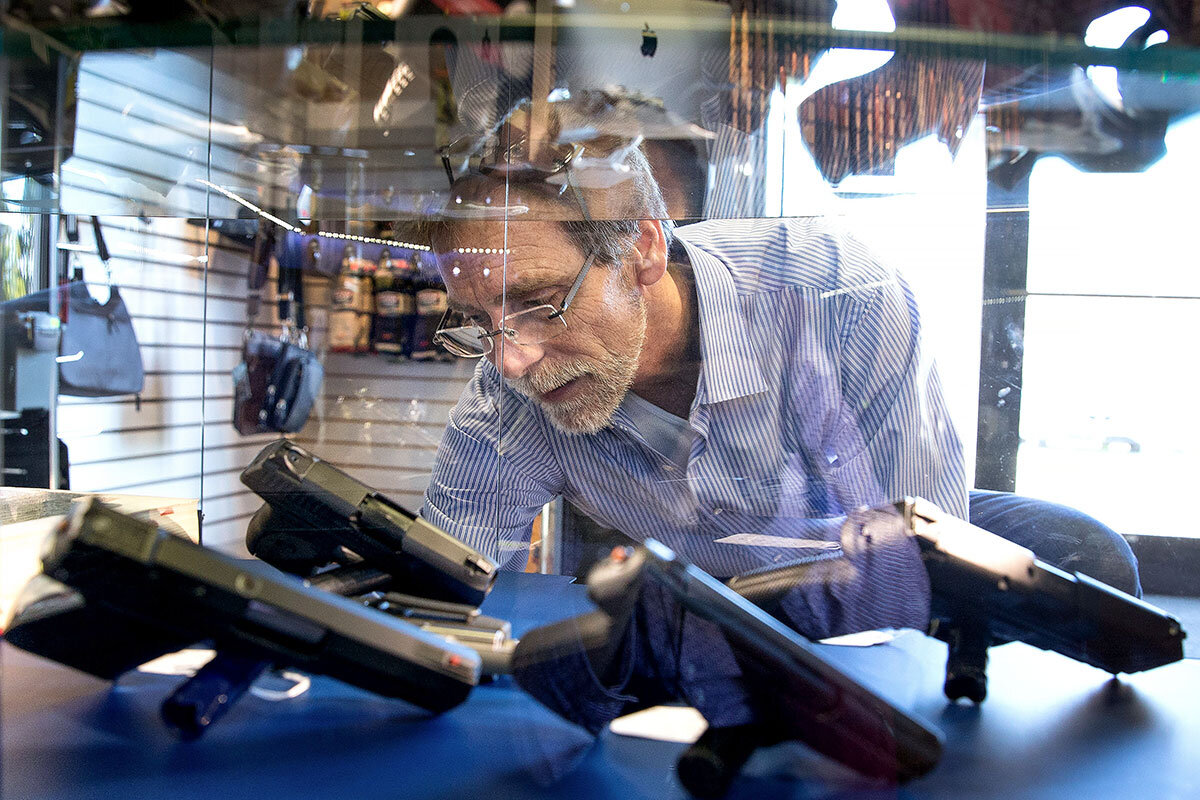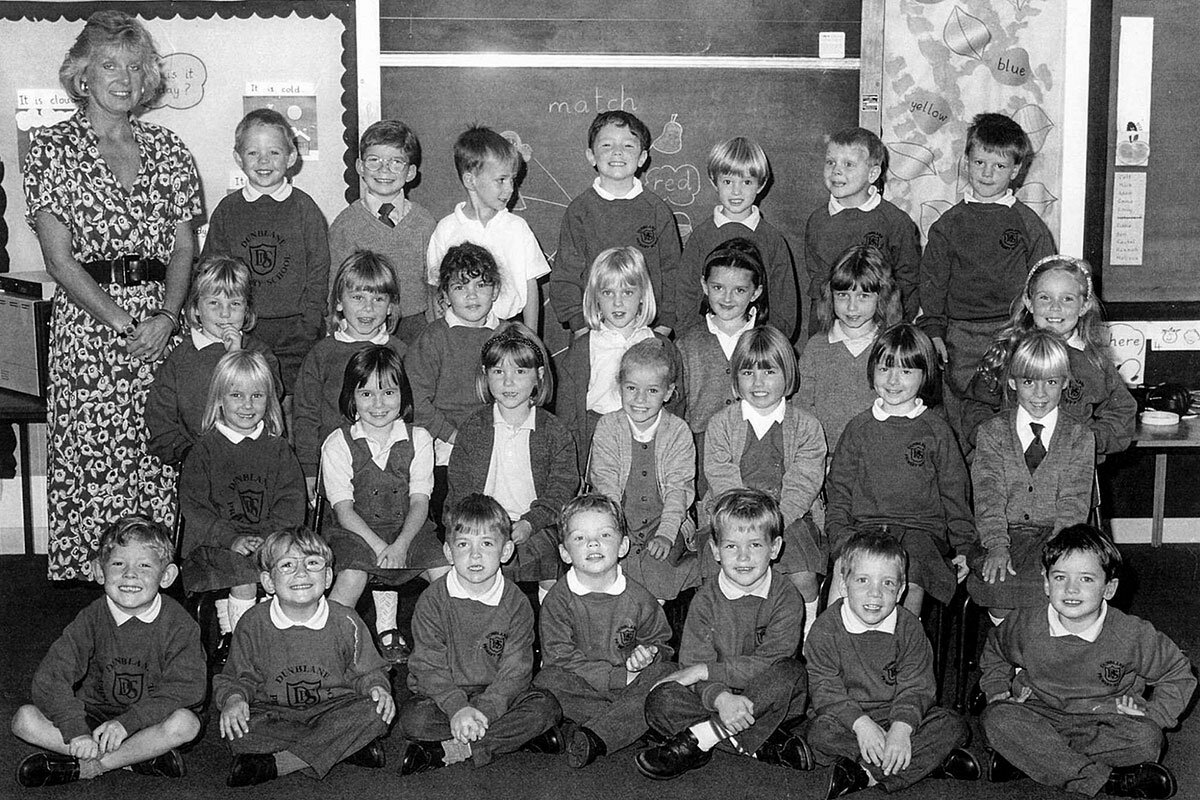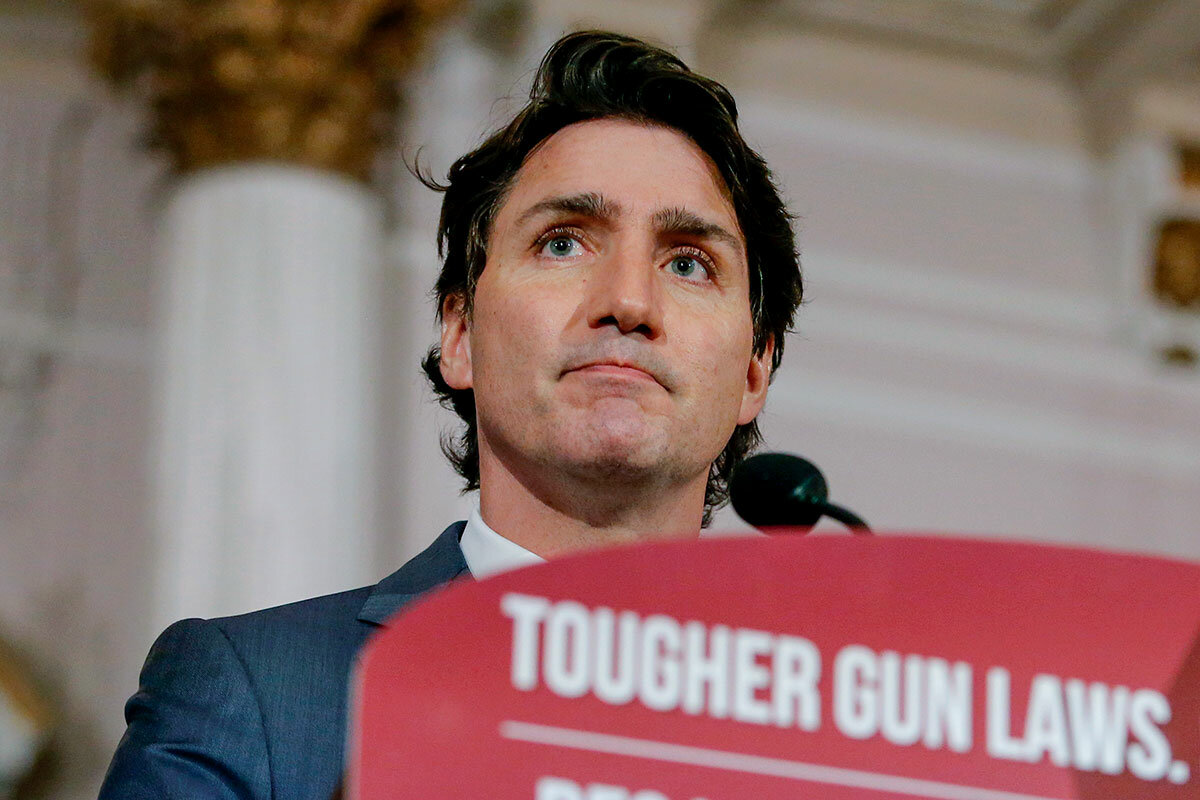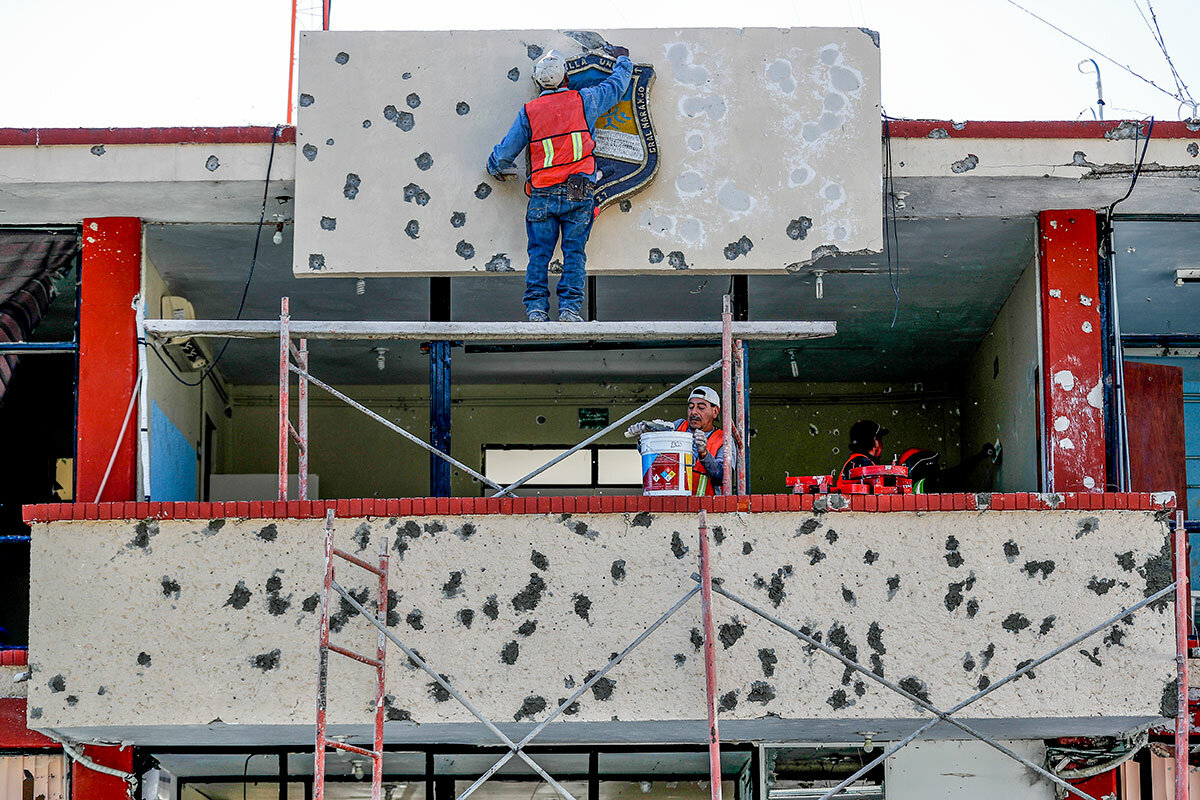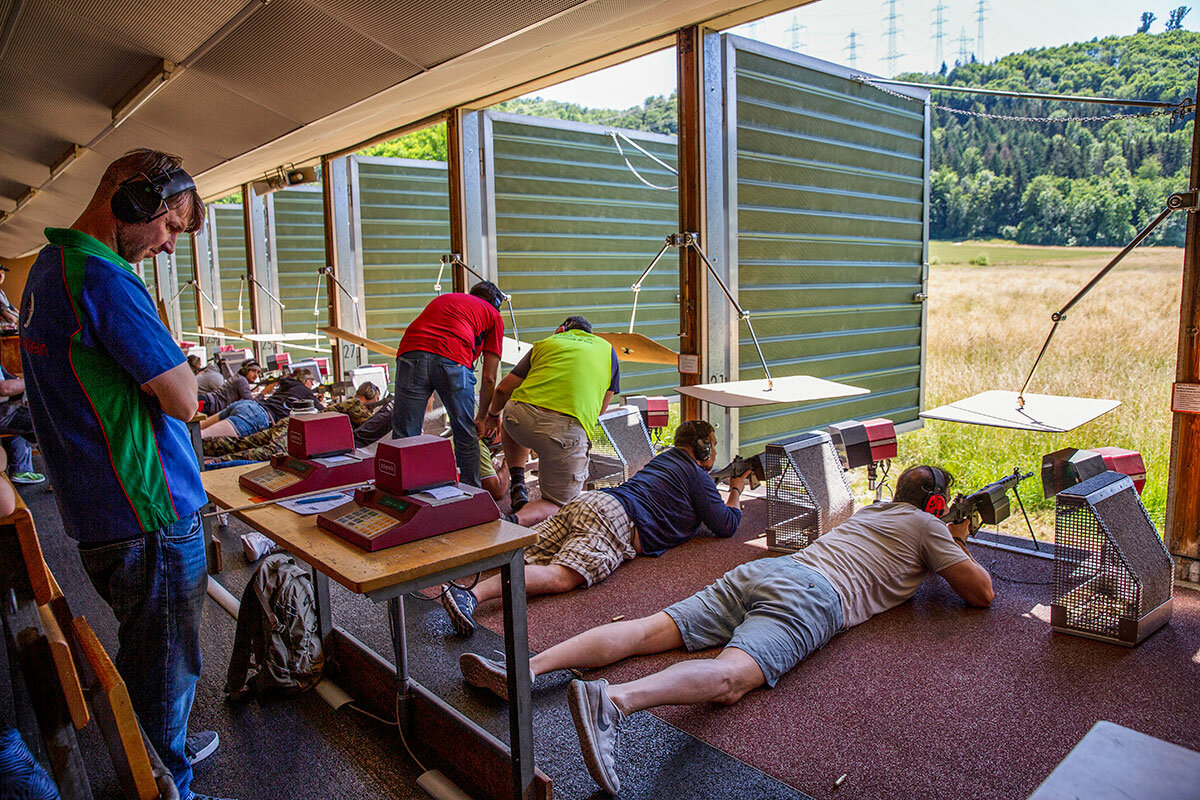What underlies US inertia on mass shootings? It may be lack of trust.
Loading...
| Raleigh, North Carolina; Mexico City; Basel, Switzerland; and Toronto
As a commercial pilot certified to carry a gun while he flies, Paul Valone has had training on how to use a firearm to neutralize mass shooters and thwart terrorists.
It’s not with glee that the North Carolinian had to learn how to unjam a gun with one hand or manage it blindfolded. Rather he sees his skills acquisition as a civic duty, at a time when he says values are fraying in American life��– underscored by the latest shooting to shock the nation: seven people shot dead at a Fourth of July parade in Highland Park, Illinois. It happened less than six weeks after 19 elementary school students and two teachers were shot dead in May in their classroom in Uvalde, Texas.
Like 63% of American gun owners polled by Gallup in 2019, Mr. Valone carries a weapon for self-protection – relying on himself to keep his family and friends safe.
Why We Wrote This
Gun regulation comes down to a question of who do people trust with their safety. Is it government? Fellow citizens? Or only themselves? How publics respond explains the differences between the gun culture of the U.S. and other countries.
“Weapons shouldn’t be comfortable. They should be comforting,” says Mr. Valone, a federal flight deck officer and president of Grass Roots North Carolina, a gun rights group. “Any place I can be legally armed, you can rest assured I will be.”
Mr. Valone is part of an undeniable trend: A country filled with disquiet is holding its guns close. Each mass shooting reignites a long-standing fight for more gun control��– and a sense of disbelief around the world that anyone would see another solution. But Americans have for protection, not fewer to try to end the violence.
“Too many guns are purchased in our society because people don’t trust their fellow Americans,” says U.S. historian Randolph Roth, author of “American Homicide.”
Around the world, the question of who national societies trust most when it comes to guns and public safety rarely follows the U.S. example of prioritizing individual discretion with weapons.
In countries from Norway to New Zealand, the United Kingdom to Canada, where mass shootings have shocked nations, publics have put their trust in the authority of democratic governments. In Switzerland, which has one of the highest per capita rates of gun ownership in the world, citizens rely on one another��– not just themselves – to maintain a healthy culture of gun safety, centered around a common good.
And in Latin America, a region among the most violent in the world and where trust of institutions and one another is much lower than in the U.S., a mentality of arming oneself doesn’t emerge, in no small part because of doubts about the example the United States has set.
Whatever the locale, trust remains a key factor in determining how a nation responds to guns. Exploring the levels of trust��– in institutions and in each other – helps explain some of the gaping disconnect between the U.S. and the rest of the world when it comes to mass shootings.
Avoiding “the American road”
The Scottish voices in the video message are sober. “We want you to know that change can happen,” they say. “It won’t be easy, but continue to remind everyone of exactly what happened at your school and of the devastation caused by just one person with one legally owned gun. Never let anyone forget.”
They are the survivors of a shooting in Dunblane, Scotland, 22 years prior, addressing student survivors of the attack on a Parkland, Florida, high school in 2018, when a gunman murdered 17 people.
After the mostly 9-, 10-, and 11-year-olds were killed in Uvalde, Texas, the message of activists who managed to change British gun laws after Dunblane remains unchanged. “Be brave. Be ambitious,” says Gill Marshall-Andrews, chair of the Gun Control Network, which was formed out of a civil society movement after the massacre.
The American gun debate has always stood out, not just because of its proportions but also its composition. Since its frontier founding, gun laws are protected under the U.S. Constitution, and the National Rifle Association is singular when compared with other gun lobbies globally in its power to protect those rights.
Yet gun control is polarizing everywhere, and public trust has had to be earned. It was so divisive in the United Kingdom in 1996 that campaigners received death threats. “In 1996 pistol shooting was the fastest growing sport in the U.K., and we were told there couldn’t possibly be a ban on handguns because of that. We were told this was all too ambitious,” says Ms. Marshall-Andrews. “But we managed to get a complete ban. It’s totally transformed the culture of guns in this country. We were going down the American road.”
That was a quarter century ago. There have been only three mass shootings, and not a single school shooting, in the U.K. since. In the U.S., figures by Jaclyn Schildkraut for the Regional Gun Violence Research Consortium show 402 mass shootings in the U.S. between 1966 and 2020, the numbers steadily rising with each decade. They do not include gang violence or terrorist attacks .
When societies have been faced with the kind of tragedies that come with stories like that of Aiden McCarthy, the toddler found wandering alone at Highland Park on July 4 after both his parents were shot dead, most have moved legislatively��– and effectively��– to prevent a repeat.
Australia pushed through a gun buyback program after the 1996 massacre in Port Arthur, Tasmania. Research shows the proportion of Australians who hold a gun license fell by 48% between 1997 and 2020. New Zealand banned semiautomatic rifles less than a week after a far-right extremist killed 51 members of a mosque in 2019.
Canada tightened its gun laws after a 1989 mass shooting of 14 women at Montreal’s École Polytechnique. And while the U.S. last month did see passage of its first major gun safety legislation in a quarter century in response to the Uvalde school shooting, boosting so-called red flag laws and bolstering background checks for those under 21, it was the U.S.’s neighbor to the north that moved more radically. Within a week of Uvalde, Canada introduced new legislation to freeze buying, importing, and selling handguns.
“We need only look south of the border to know that if we do not take action, firmly and rapidly, it gets worse and worse and more difficult to counter,” Canadian Prime Minister Justin Trudeau said.
“A gun isn’t going to help them”
South of the U.S. border, Mexico is awash in guns and violence. Americans see images of daylight shootouts in public squares or quinceañeras��– the kind of barbarity that can seem like a Hollywood production.
But along the broad sidewalks outside the Benito Juárez elementary school in central Mexico City, one thing Fernando Rendon doesn’t worry about is a mass shooting inside his 8-year-old son’s classroom.
“It’s just not that easy to get a gun,” says the father, as families schlep backpacks festooned with cartoon characters at school dismissal and kids eat bright-pink strawberry popsicles on their walks home.
There have been three school shootings in Mexico since 2014. But the subsequent national conversation in Mexico after their recent school shootings, including one in 2020, has focused on the erosion of family values, mental health, and the corrupting nature of violent video games. Access to guns is rarely mentioned. That’s in part because it’s so hard to legally obtain one in the first place, leaving weapons to circulate mostly among criminals.
But amid such high rates of violence, in a culture that focuses on family and community, and given its trajectory of gun laws, a mentality of arming oneself��– the values Mr. Valone espouses, for example��– doesn’t take root.
“I think a lot of people calculate a gun isn’t going to help them” in Mexico and other parts of Latin America, says Adam Isacson, director for defense oversight at the Washington Office on Latin America, a research and advocacy organization. “Gangs are either really well armed or control the local police – or control everything in a neighborhood. If you kill one [gang member], even in self-defense, you’re in even greater danger,” he says.
Today, Mexico has some of the strictest gun-control laws in the hemisphere, which makes legally obtaining a firearm a lengthy – and pricey – endeavor. There are about 16.8 million firearms in civilian hands in Mexico, roughly 4% the total number of guns in the U.S., according to the Small Arms Survey based in Switzerland.
And from the southern vantage, Mexicans have a clear view on vicious cycles of armament��– and how American gun laws make their security worse. In 2004, the U.S. ban on assault weapons expired, and almost immediately . one study showed that,��between 2014 and 2018, 70% of guns traced in Mexico came from the U.S., according to the U.S. Bureau of Alcohol, Tobacco, Firearms, and Explosives.
Last year, the Mexican government filed a historic suit against a handful of U.S.-based gun manufacturers for what they see as their role in the steady flow of arms that cross into Mexico from the U.S. each year.
Some politicians in the region have tried to loosen gun laws to deal with their own violence. In the past year, politicians on the right in Chile, Brazil, and Colombia have put forth proposals that lean into individual rights to bear arms and access weapons. In 2016 a proposal was floated in the Mexican Senate to allow guns to be carried in cars and private companies but was roundly rejected.
Eugenio Weigend Vargas, the director for Gun Violence Prevention at the Center for American Progress, researches gun violence and trafficking in the U.S. and Mexico. He says some politicians in Latin America may be “repeating the narrative you hear in the U.S.” around gun rights, but “the overall perception is that people look at the U.S. and say ‘I don’t want to be like that.’”
In Mexico, amid corruption scandals and allegations that police and military officers are often co-opted by the drug trade, trust of authorities is low. Only 25% of Mexicans . That leads to low interpersonal trust. According to Inter-American Development Bank research, only 12.4% of Mexicans agree with the statement “Most people can be trusted.” That compares with 39.6% in the U.S. and 49.3% in Switzerland.
“Mexico is a weak state, and that means that in many cases, individual citizens and communities are left to defend themselves,” says David Shirk, an expert in organized crime and violence in Mexico at the University of San Diego.
Usually that means additional security��– from tall walls constructed outside houses, to private security details and armored cars for wealthly people, to moving your family from one neighborhood to another – or even fleeing the country. “It underscores to me that people realize having a gun is not going to make you safer,” says Mr. Shirk.
Outside the Benito Juárez school, first grade teacher Veronica, who doesn’t give her last name because she wasn’t authorized to speak to the media, says her institution carried out an informal poll on whether or not to check backpacks for weapons following the Uvalde shooting. But such checks have raised human rights concerns in Mexico, and she says she doesn’t expect a new policy to go into place, as she adjusts her hot-pink-framed glasses after school. “They don’t have access to guns, so I don’t really think about that.”
Communal responsibility
Swiss youth, on the other hand, have easier access to guns.
On a sweltering June weekend, men, boys, and families gathered at Switzerland’s , held at sites across the country and billed by organizers as the world’s largest shooting competition, with roots dating back to 1872.
At one of the competition’s sites outside Basel, participants as young as 14 gathered for the mid-June annual festival, some in full folkloric costume or military attire despite the heat. In a nation with a standing militia, where military service is compulsory for all men, the gun has a long tradition here. And while it symbolizes death and divisive politics in many places in the world, guns reflect for many here a national ideal��– and fun.
Elia Sammarruco, a 20-year-old participant, compares shooting to meditation after one of his events, stressing he prefers real shooting to the virtual version in video games. “It’s just you, the gun, and the target,” he explains. “So I can leave all my thoughts and just focus. ... Gaming sometimes can be really stressful and hectic and fast. Here it is slow. You take your time.”
Switzerland counts 2,500 shooting clubs nationwide. With about 130,000 members, the Swiss Shooting Association is the largest sports club in the country. Local communal ranges like this one outside Basel are a feature of Swiss life, like hockey rinks in Canada or baseball diamonds in the U.S.
“It’s a wonderful tradition,” says Steven Bleuler, a member of the Schiess-Sport Helvetia Basel club. “I can go shooting with my grandfather, with my father, with my brother ... [and] if I had children of the right age they could come shooting.”
Switzerland hasn’t been spared mass shootings. A 2001 attack in the canton of Zug, when a gunman stormed the parliamentary chamber and killed 14, shook the nation. It helped usher in greater restrictions that have tightened over the years, including ones imposed by the European Union after the Bataclan terrorist attack in Paris in 2015. But guns, and the restriction of them, have not become a major wedge issue in part because citizens get to weigh in on such regulations in referendums.
The Swiss have found consensus on the issue��– putting trust in each other and the rules they have agreed upon to keep guns safe.
Sandro Klotter teaches seven young shooters in the nearby town of Arlesheim. They all had to master handgun expert Jeff Cooper’s four safety rules – consider every gun loaded, don’t aim at something you don’t want to hit, keep your trigger finger straight, be aware of your target and what’s around it��– before getting a weapon.
“My guys, they don’t get a gun unless they can recite that,” he says. “I must be sure that I can call them at 3 o’clock in the morning and ask them what is safety rule No. 3? Safety is No. 1.”
The shooting community knows avoiding accidents is key to keeping their treasured tradition going��– and avoiding tighter regulations. “There is really a trust from the government towards us that we are responsible with the rifles and the guns,” says Mr. Bleuler. “Us shooters look all the time at security. Security is all the time in focus. We don’t want an accident to happen.”
Switzerland has on average about 50 homicides per year. Including attempted murders, guns were used only in 10% of the cases in 2019, according to Swiss federal statistics. In the U.S., where figures leave out attempted homicides, 67% of murders involved a gun that year, says Marcelo Aebi, professor of criminology at the University of Lausanne, Switzerland.
“One key difference between��Switzerland��and the United States is that military service is mandatory for men,” he says. “That means every man considered to be sound of mind and physically able receives training on��gun��safety.
While the option of purchasing one’s weapon after completing service and taking it home was once the norm, those who do are today a tiny minority, Dr. Aebi adds. In 2004, 43% of people serving were purchasing their service arms. That represented 20,000 assault rifles and 20,000 pistols. By 2017, in a county of 8.5 million, only 10% bought their weapons.
Dr. Aebi says a lower level of polarization allows the gun culture consensus to remain. “There has been a gradual polarization of societies everywhere, but this polarization is particularly important in the United States. This polarization that exists means that you do not trust people that do not think like you,” he says.
Switzerland, on the other hand, has a long history of neutrality and democracy, as well as a depersonalized style of politics since it is governed by a council of seven ministers who take turns serving as president. “[In Switzerland,] trust in institutions is high, and interpersonal confidence too.”
Trust and violence
The interplay between trust, safety, and guns is at the heart of research that Dr. Roth at Ohio State has carried out, from the colonial era to recent anti-police protests.
His basic finding: Low murder rates��tend to correlate with periods when Americans have a strong level of trust in the government and in each other.
Over history, when people were best off, violence remained low. World War II brought peace around the world, including the U.S. Murder rates dropped. The turbulent ’60s and ’70s saw violence rise again, at different rates among different groups. Murder among white people rose in the Carter era, but fell in the Reagan years. The opposite was true for Black Americans. The homicide rate peaked in Los Angeles in 1992��– the year that the Rodney King riots stunned the nation. And then the murder rate went down.
Then there was the killing of Michael Brown in Ferguson, Missouri; the Malheur protests in Oregon; the white nationalist rally in Charlottesville, Virginia; and protests against the murder of George Floyd in 2020��– the anger bleeds into violence. At the same time, the murder rate rises.
The pandemic flamed new iterations of “them” versus “us,” and two years ago, the U.S. saw a record 23 million guns sold. This year has seen the highest number of mass shooting victims in history.
The new U.S. gun control law has been hailed as a significant step forward to lower the temperature – mostly because it’s at least a step. “We have not been able to pass anything significant in 30 years. The last gun laws were passed when I was 10,” says Lanae Erickson, senior vice president for social policy, education, and politics at the center-left think tank Third Way.
That does not reflect the moderate position that most Americans hold. In new polling by Third Way in Washington after Uvalde, 73% of respondents in North Carolina said it was too easy to get a gun.
Mr. Valone is opposed to the new U.S. gun control law; he protested at the office of Sen. Thom Tillis of North Carolina, a Republican who helped pen it. After Highland Park, he says further restrictions, from an assault weapons ban to trigger laws, wouldn’t have made a difference in this case.
Instead, he has dedicated tireless hours as an activist trying to build bipartisan support in his own state for improving mental health reporting for background checks. He also supports more federal funding for school security.
“Gun owners are saying, ‘What can we do?’ But our philosophy of what can we do is dramatically different than people who think they are going to disarm violent sociopaths,” says Mr. Valone. “And to deter a violent sociopath, you have to convince him that he’s likely to encounter an armed American who isn’t prepared that day to be a victim.”
The trick moving forward, says Ms. Erickson, is convincing gun rights activists like Mr. Valone that restrictions won’t make America less safe, and on the other hand, convincing the most ardent gun opponents that guns don’t need to be abolished.
“If we can show proof of concept that it works, then we can maybe talk about the next thing that we agree on. And I think it’s much more likely at this point that those kinds of conversations are going to happen in civil society than in Congress. I do think this moment of incremental progress could both restore trust that we can have a conversation about gun safety without talking about confiscating all guns,” she says, “and also that Congress can actually get something done.”��
Shafi Musaddique contributed reporting from London.



